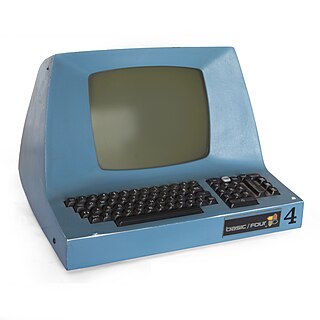
Compaq Computer Corporation was an American information technology company founded in 1982 that developed, sold, and supported computers and related products and services. Compaq produced some of the first IBM PC compatible computers, being the second company after Columbia Data Products to legally reverse engineer the IBM Personal Computer. It rose to become the largest supplier of PC systems during the 1990s before being overtaken by Dell in 2001. Struggling to keep up in the price wars against Dell, as well as with a risky acquisition of DEC, Compaq was acquired for US$25 billion by HP in 2002. The Compaq brand remained in use by HP for lower-end systems until 2013 when it was discontinued. Since 2013, the brand is currently licensed to third parties for use on electronics in Brazil and India.

Digital Equipment Corporation, using the trademark Digital, was a major American company in the computer industry from the 1960s to the 1990s. The company was co-founded by Ken Olsen and Harlan Anderson in 1957. Olsen was president until forced to resign in 1992, after the company had gone into precipitous decline.

The IBM Personal Computer is the first microcomputer released in the IBM PC model line and the basis for the IBM PC compatible de facto standard. Released on August 12, 1981, it was created by a team of engineers and designers directed by Don Estridge in Boca Raton, Florida.
Tandy Corporation was an American family-owned leather-goods company based in Fort Worth, Texas, United States. Tandy Leather was founded in 1919 as a leather supply store. By the end of the 1950s, under the tutelage of then-CEO Charles Tandy, the company expanded into the hobby market, making leather moccasins and coin purses, making huge sales among Scouts, leading to a fast growth in sales.
Micro Instrumentation and Telemetry Systems (MITS) was an American electronics company founded in Albuquerque, New Mexico that began manufacturing electronic calculators in 1971 and personal computers in 1975.
Prime Computer, Inc. was a Natick, Massachusetts-based producer of minicomputers from 1972 until 1992. With the advent of PCs and the decline of the minicomputer industry, Prime was forced out of the market in the early 1990s, and by the end of 2010 the trademarks for both PRIME and PRIMOS no longer existed

AST Research, Inc., later doing business as AST Computer, was a personal computer manufacturer. It was founded in 1980 in Irvine, California by Albert Wong, Safi Qureshey, and Thomas Yuen, as an initialism of their first names. In the 1980s, AST designed add-on expansion cards, and evolved toward the 1990s into a major personal computer manufacturer. AST was acquired by Samsung Electronics in 1997 but was de facto closed in 1999 due to a series of losses.

Seattle Computer Products (SCP) was a Tukwila, Washington, microcomputer hardware company which was one of the first manufacturers of computer systems based on the 16-bit Intel 8086 processor. SCP began shipping its first S-100 bus 8086 CPU boards to customers in November 1979, about 21 months before IBM introduced its Personal Computer which was based on the slower 8088 and introduced the 8-bit ISA bus. SCP shipped an operating system for that hardware about a year before the release of the PC, which was modified by Microsoft for the PC and renamed IBM PC DOS. SCP was staffed partly by high-school students from nearby communities who soldered and assembled the computers. Some of them would later work for Microsoft.
The BUNCH was the nickname for the group of mainframe computer competitors of IBM in the 1970s. The name is derived from the names of the five companies: Burroughs, UNIVAC, NCR, Control Data Corporation (CDC), and Honeywell. These companies were grouped together because the market share of IBM was much higher than all of its competitors put together.
Satellite Business Systems (SBS) was a company founded by IBM, Aetna, COMSAT, that provided private professional satellite communications through its SBS fleet of FSS geosynchronous satellites, and was the first company to do so.
Cincom Systems, Inc., is a privately held multinational computer technology corporation founded in 1968 by Tom Nies, Tom Richley, and Claude Bogardus.
Pertec Computer Corporation (PCC), formerly Peripheral Equipment Corporation (PEC), was a computer company based in Chatsworth, California which originally designed and manufactured peripherals such as floppy drives, tape drives, instrumentation control and other hardware for computers.

Computer City was a chain of United States-based computer superstores operated by Tandy Corporation; the retailer was sold to CompUSA in 1998 and was merged into the CompUSA organization.
International Business Machines (IBM) is a multinational computer technology and IT consulting corporation headquartered in Armonk, New York, United States. IBM originated from the unification of several companies that worked to automate routine business transactions, including the first companies to build punched card based data tabulating machines and to build time clocks. In 1911, these companies were amalgamated into the Computing-Tabulating-Recording Company (CTR).

The IBM JX was a personal computer released in 1984 into the Japanese, Australian and New Zealand markets. Designed in Japan, it was based on the technology of the IBM PCjr and was designated the IBM 5511. It was targeted in the Australasian market towards the public education sector rather than at consumers, and was sold in three levels: JX (64 KiB), JX2 (128 KiB) and JX3 (256 KiB). Upgrades were available to both 384 KiB and 512 KiB. The JX was the first IBM PC to use 3.5" floppy drives.

Basic/Four is a variety of Business Basic which originally ran on computers of the same name introduced in 1971. The company that produced the system, Management Assistance, Inc., was later known as Basic/Four Corporation, MAI Basic Four, Inc., and MAI Basic Four Information Systems.
Victor Technology LLC is a supplier of printing calculators, scientific calculators, financial calculators, basic calculators, and desktop accessories with headquarters in Bolingbrook, Illinois. Victor products are sold primarily throughout the United States, Canada, and Puerto Rico through independent office supply dealers.

John Sexton & Company, also known as Sexton Quality Foods, was a broad line national wholesale grocer that serviced the restaurant, hotel and institutional trade from regional warehouses and truck fleets located in major metropolitan areas of the United States. Sexton Quality Foods eventually became US Foodservice in 1997. The company was established in Chicago in 1883 by John Sexton.

The history of the personal computer as a mass-market consumer electronic device began with the microcomputer revolution of the 1970s. A personal computer is one intended for interactive individual use, as opposed to a mainframe computer where the end user's requests are filtered through operating staff, or a time-sharing system in which one large processor is shared by many individuals. After the development of the microprocessor, individual personal computers were low enough in cost that they eventually became affordable consumer goods. Early personal computers – generally called microcomputers – were sold often in electronic kit form and in limited numbers, and were of interest mostly to hobbyists and technicians.

Hitachi Data Systems (HDS) was a provider of modular mid-range and high-end computer data storage systems, software and services. Its operations are now a part of Hitachi Vantara.










